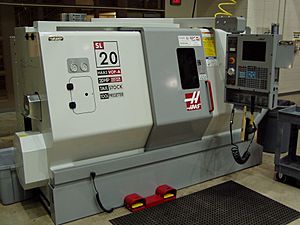Numerical control facts for kids
Numerical Control (often called NC) is a cool way to make machines work all by themselves! Instead of someone controlling them by hand, these machines get their instructions from a special storage place. Think of it like a robot following a recipe.
The very first machines like this were Jacquard looms, which made patterns on fabric using special cards with holes punched in them. Later, in the 1940s and 1950s, machines that cut metal started using instructions from punched tape. Soon, people realized that computers could do an even better job. When computers are used to control these machines, it's called Computer Numerical Control or CNC.
Today, engineers can design something on a computer using CAD (Computer-Aided Design) software. Then, they can make a program from that design that tells a CNC machine exactly how to create the real object!
Contents
How Machines Learned to Work Alone
Before modern NC and CNC, people tried to automate machines in simpler ways. For example, in the 1800s, some machines like "copying-lathes" used things called cams.
What are Cams?
Imagine a special wheel with bumps and dips on its edge. As this wheel turns, the bumps and dips push or pull other parts of the machine, making it move in a certain way. Cams were good for making a machine do one specific job over and over again.
The Big Difference
The main difference between old cams and modern NC or CNC machines is how much they can do. Cams could only automate one task. But modern NC and CNC machines are much smarter! You can program them to do many different tasks and create all sorts of complex shapes, just by changing the instructions.
Images for kids
See also
 In Spanish: Control numérico para niños
In Spanish: Control numérico para niños




